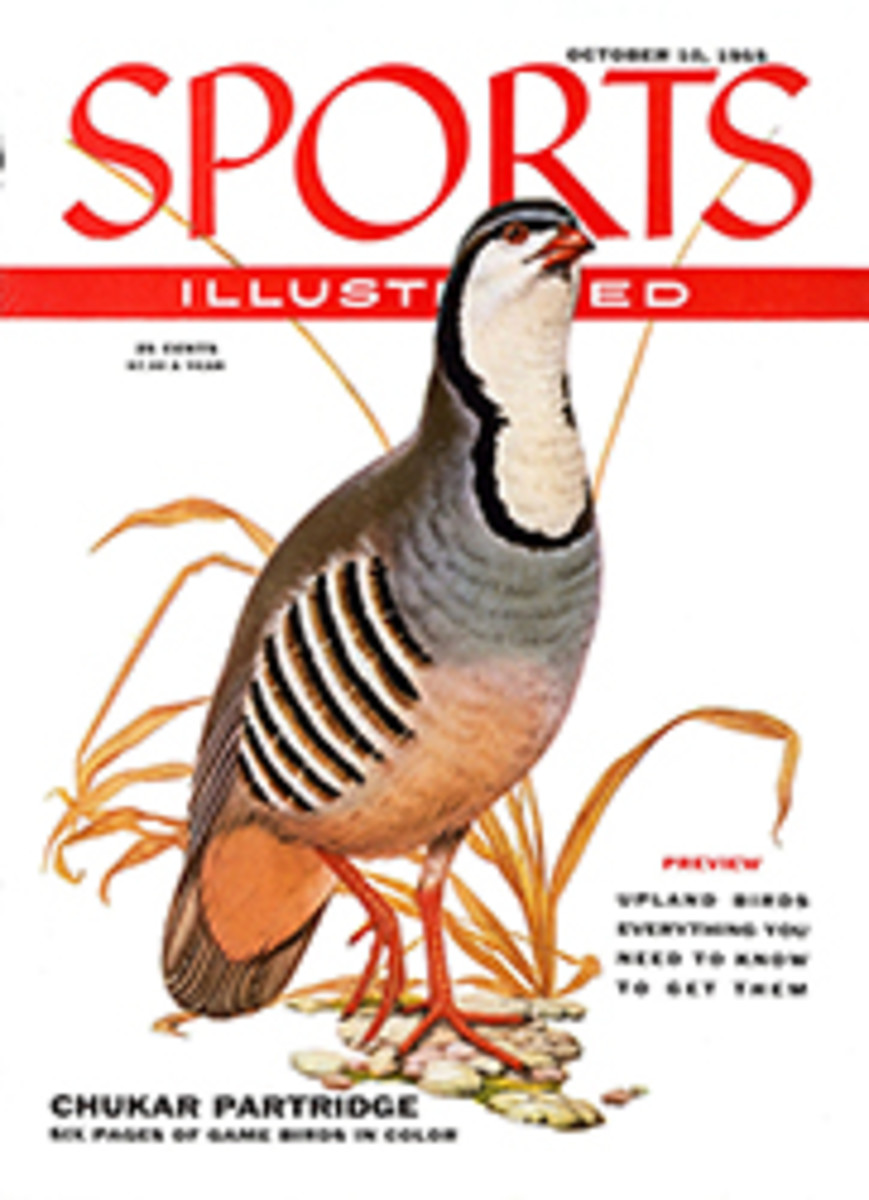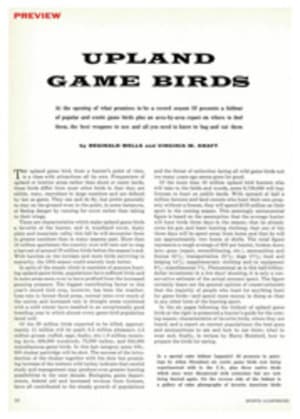
UPLAND GAME BIRDS
The upland game bird, from a hunter's point of view, is a class with attractions all its own. Frequenters of upland or interior areas rather than shore or water lands, these birds differ from most other birds in that they are edible, wary, reproduce in large numbers and are defined by law as game. They can and do fly, but prefer generally to stay on the ground even to the point, in some instances, of fleeing danger by running for cover rather than taking to their wings.
These are characteristics which make upland game birds a favorite of the hunter, and in woodland cover, dusty plain and mountain valley this fall he will encounter them in greater numbers than in many seasons past. More than 10 million sportsmen the country over will turn out to reap a harvest of around 29 million birds before the season's end. With hatches on the increase and more birds surviving to maturity, the 1955 season could scarcely look better.
In spite of the steady climb in numbers of gunners hunting upland game birds, populations have suffered little and in some areas seem even to have profited from the increased gunning pressure. The biggest contributing factor to this year's record bird crop, however, has been the weather. Less rain in former flood areas, normal rains over much of the nation and increased rain in drought areas combined with a mild winter have resulted in an exceptionally good breeding year in which almost every game-bird population fared well.
Of the 29 million birds expected to be killed, approximately 11 million will be quail; 6.5 million pheasant; 4.5 million grouse (ruffed, sage, dusky, etc.); 6 million mourning dove; 300,000 woodcock; 70,000 turkey, and 630,000 miscellaneous game birds. In this last category some 100,000 chukar partridge will be shot. The success of the introduction of the chukar together with the slow but promising increase of the western wild turkey indicate that careful study and management may produce even greater hunting possibilities in the next decade. Biologists, game departments, federal aid and increased revenue from licenses, have all contributed to the steady growth of populations and the threat of extinction facing all wild game birds not too many years ago seems gone for good.
Of the more than 10 million upland bird hunters who will take to the fields and woods, some 9,750,000 will buy licenses to hunt on public lands. With upward of half a million farmers and land owners who hunt their own property without a license, they will spend $478 million on their sport in the coming season. This seemingly astronomical figure is based on the assumption that the average hunter will hunt birds three days in the season; that he already owns his gun and basic hunting clothing; that one of the three days will be spent away from home and that he will use approximately two boxes of shells. The total figure represents a rough average of $50 per hunter, broken down into: guns (repair, reconditioning, etc.), ammunition and license 32%; transportation 22%; dogs 17%; food and lodging 14%; supplementary clothing and/or equipment 8%; miscellaneous 7%. Phenomenal as is this half-billion-dollar investment in a few days' shooting, it is only a conservative estimate of the actual amount spent. The figure certainly bears out the general opinion of conservationists that the majority of people who hunt for anything hunt for game birds—and spend more money in doing so than in any other form of the hunting sport.
In the six pages following the foldout of upland game birds at the right is presented a hunter's guide for the coming season: characteristics of favorite birds, where they are found, and a report on current populations; the best guns and ammunitions to use and how to use them; what to wear and, finally, in recipes by Harry Botsford, how to prepare the birds for eating.
In a special color foldout (opposite) SI presents in paintings by Athos Menaboni six exotic game birds now being experimented with in the U.S., plus three native birds which once were threatened with extinction but are now being hunted again. On the reverse side of the foldout is a gallery of color photographs of favorite American birds
SPANISH RED-LEGGED PARTRIDGE
Colorado has experimentally released some of these birds in the southeastern part of the state, hoping they will suit the region
BLACK GROUSE
A great European favorite, it was stocked on Wisconsin's Outer Island in Lake Superior but predators killed all. Stockings are planned elsewhere
EASTERN WILD TURKEY
The largest member of the pheasant family, this storied bird has been successfully reintroduced in its original habitat, notably in Pennsylvania.
CHUKAR CARTRIDGE
Comes from Asia and thrives in many parts of the West. It will be hunted this year mostly in Nevada, California, Idaho, Washington and Wyoming
TURKISH GRAY CARTRIDGE
Kansas is testing the suitability of this close relative of the Hungarian partridge (long a success in U.S.) after failing with chukars
SHARP-TAILED GROUSE
This bird of the prairies is now thriving in northern Pennsylvania where large areas have been depredated by forest fires
CAPERCAILLIE
Almost turkey-sized, this enormous bird—a fringe member of the grouse family—has been often introduced without success into U.S. from Europe
BLACK FRANCOLIN
Specimens trapped in eastern Turkey are being bred in Arizona and New Mexico in the hope of finding new habitats for this partridge
MERRIAM TURKEY
A native western bird, it has now been spread widely throughout the West and is being hunted in new regions every year
SOME OLD FRIENDS
PRAIRIE CHICKEN
Once abundant throughout the great plains states, the prairie chicken (pinnated grouse) has diminished before civilization's advance
RINGNECK PHEASANT
First successfully transplanted to the U.S. in 1881—from China to Oregon—this bird has scattered widely to all but five states
SAGE GROUSE
Shunning fertile areas, this largest of true grouse dwells in wastelands of the sagebrush country in western states
RUFFED GROUSE
Pilgrim fathers found the "ruff neck" plentiful. It was then a trusting and easy mark. Main concentration is still in the northeast states
WOODCOCK
A shy, spooky little fellow, this cousin of the snipe is found chiefly in the Atlantic seaboard uplands but also occurs in many other localities
DUSKY GROUSE
Has inhabited the pine forests of the West since long before the white man came. So trusting, it is known also as "fool hen"
GAMBEL QUAIL
When startled this desert dweller runs off rapidly to hide among mesquite and cactus. If forced to it can make a short, speedy flight
MOURNING DOYE
So called because of its plaintive cry. Has the distinction among game birds of breeding in all states. Can do 60 mph with throttle open
BOBWHITE QUAIL
A large and very popular family, "Bob" is represented in our country by five distinct genera and many subspecies. Found mostly in the southland
NINE ILLUSTRATIONS
NINE PHOTOS

